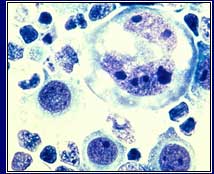
Lymphoma cells
Multiple myeloma is a cancer of plasma cells. Normal plasma cells, which are derived from B-lymphocytes (a type of white blood cell), are typically found within bone marrow. Their role in the immune system is to secrete large amounts of immunoglobulin proteins (antibodies) to circulate in the blood. Each plasma cell secretes only one kind of antibody (monoclonal immunoglobulin), but a collection of different plasma cells secrete many kinds of antibodies (polyclonal immunoglobulin). When foreign substances such as bacteria or viruses enter the body, they specifically stimulate lymphocytes to become a type of plasma cell that secretes polyclonal antibodies. These antibodies can then attack and neutralize foreign invaders, thus preventing infection and disease.
The term multiple myeloma describes a characteristic feature of this cancer; found at multiple sites within the bone marrow (myelo-) with accumulations of tumor (-oma) cells. Unlike normal plasma cells that typically comprise about one percent of the cells in the bone marrow, monoclonal multiple myeloma cells are overproduced so that they comprise 10 percent to 80 percent or more of the cells in the bone marrow. Although the tumor cells mostly remain within the bone marrow, they can cause a number of complications, such as localized bone destruction that can result in severe pain and fractures; anemia and decreased immunity to infection by crowding out normal cells in the bone marrow; and kidney damage due to the high concentrations of monoclonal antibodies. Additionally, excessive calcium from bone destruction may lead to weakened muscle, general malaise and fatigue, and sometimes mental confusion.
An estimated 16,000 new cases of multiple myeloma will be diagnosed in the United States during 2005. Despite advances in therapy that improve the quality of life and length of survival, it presently remains an incurable disease. The average 5-year survival rate for patients diagnosed with the disease is about 30 percent; young patients fare better than the elderly. In addition to drugs that inhibit the destruction of bone, conventional treatment for multiple myeloma involves chemotherapy and corticosteroids. High dose chemotherapy followed by bone marrow transplantation provides an added therapeutic benefit. Nevertheless, 50 percent to 75 percent of patients see their cancer return within two to three years, and eventually almost all patients become resistant to therapy. Treatment then focuses on complications or supportive care. However, new therapies and treatment may offer better outcomes in the future.
One newer treatment for multiple myeloma is thalidomide, which was originally introduced as a sedative in the 1960s. Birth defects were discovered with its use as a sedative and it was soon withdrawn from the market. Thalidomide represents the first of a new class of novel drugs that show promise in treating multiple myeloma in both newly diagnosed patients and those patients resistant to standard treatments. Thalidomide is used as both a single agent and in combination with other therapies. However, many patients experience severe side effects when treated. For example, numbness and tingling in the limbs may occur, which often can be severe and, over time, irreversible. These side effects have led clinicians and scientists to explore similar agents with reduced adverse effects. Recently, lenalidomide (Revlimid®) received a fast-track designation from the U.S. Food and Drug Administration (FDA) to evaluate its effectiveness for both multiple myeloma and malignant blood cell disorders known as myelodysplastic syndromes. Additionally, the FDA recognized the potential for these new agents and has granted expedited review in clinical trials. Adverse side effects of these agents may prove more acceptable than those seen with thalidomide therapies.
In 2003, the FDA approved another new class of cancer drug to treat patients who show continued progression of multiple myeloma after at least two previous forms of treatment. The agent, bortezomib, is available under the trade name Velcade®. It acts by blocking particular cellular components known as proteasomes. Similar to the thalidomide class of drugs, bortezomib may have several targets, including a direct inhibitory effect on tumor cells, but also may have an inhibitory effect on other cells in the bone marrow, or on pathways that regulate the immune system. Recent clinical studies suggest that bortezomib might increase patient survival and be useful in earlier treatment. However, patients treated with this agent may experience serious side effects such as numbness and tingling in the extremities, as well bleeding disorders. Nevertheless, bortezomib has proven the importance of proteosome inhibitors in treating cancer, and appears to open a new front for treating other malignancies, such as lymphoma.
 NCI NewsCenter
NCI NewsCenter NCI Budget Data
NCI Budget Data Visuals Online
Visuals Online NCI Fact Sheets
NCI Fact Sheets Understanding Cancer Series
Understanding Cancer Series